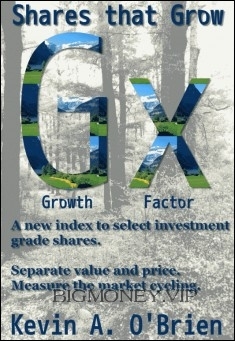Shares that Grow by Kevin Arthur O'Brien

1. Rational Share Investment
1. Rational Share Investment
This work grew out of asking the simple question of “how do I
rank shares amongst themselves as a best buy at a given date?” A
simple question, with the implications that if there was a best buy,
there was the second, third, fourth etc. if they could be so ranked.
A unique way of ranking, Gx, (Growth Factor) has been developed
by the author with implications for valuation and pricing of shares.
If the shares are only to be held for quick trading, ranking may
still be relevant to pinpoint undervaluation and potential bonus
rights issues. It may be not relevant if buy/sell decisions are made
on the basis of price pressures or charting. The implications of Gx
flow through to valuations resulting from corporate activity such
as takeovers and mergers and new offerings of securities by many
companies.
Only the pricing of shares traded on securities exchanges or
stock markets is dealt with. It is not about pricing bonds, options or
the host of other financial offerings that brokers (sales personnel)
attempt to trade. Returns on long term bonds are referred to under
index forecasting.
This research is primarily about investment-grade shares, not
necessarily those that might be included in indices. Companies
both big and small qualify—known as ‘stable’ companies from here
on.
Some relationships between speculative and stable companies
will be looked at too.
The research on which this publication is based started while
the author found himself with time on his hands while working
in Samoa. He was freshly qualified as an accountant and already
an experienced share valuer with an interest in valuation theory.
So armed with slide rule, log tables and a Facit hand-cranked
calculator which he found in the lagoon, he set to work to try and
figure out what might be a best buy. All this was done BE, before
Excel. It makes the research even more interesting that the author
is not an investor by temperament. The newspapers gave a lot of
statistics and Equity Investment published a summary of balance
sheet data so information was freely available to New Zealand and
Australian investors.
The formula developed worked both for future and historical
pricing over a period of about 40 years. For a stable company one
could, using only published data, plug in the numbers and obtain
an expected price that its common shares should be trading at on
a given day. This was precise, often to the cent. Changes occurred
when New Zealand opened up its economy. I have revisited this
research from time to time over the years.
A test of the application to the USA in 1999 revealed a situation
in IBM through comparison with Intel that would require a bonus
share issue to adjust the price to what I had determined to be
market. The stock split duly happened on May 26 1999 in
agreement with the formula. The principles to be shown are
timeless and not limited to location. Substantial movements in the
economy may require periodic updates. Some elements of pricing
are local, but the data for those should be readily available or
calculable by example.
Ultimately it shows, by inference, that the economist’s model
rational person invests in shares in stable companies using a
measurable, intrinsic value. The price paid varies with earnings,
absolute size of company, industrial activity group and ability to
pay. It proves that for the same sized companies with the same
earnings expectations the aggregate value should be the same.
This work has been hidden for many years as, frankly, I didn’t
know what to do with it. It’s hard to claim that one can tell prices




